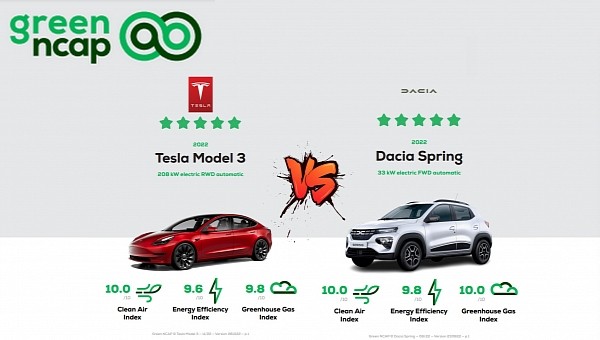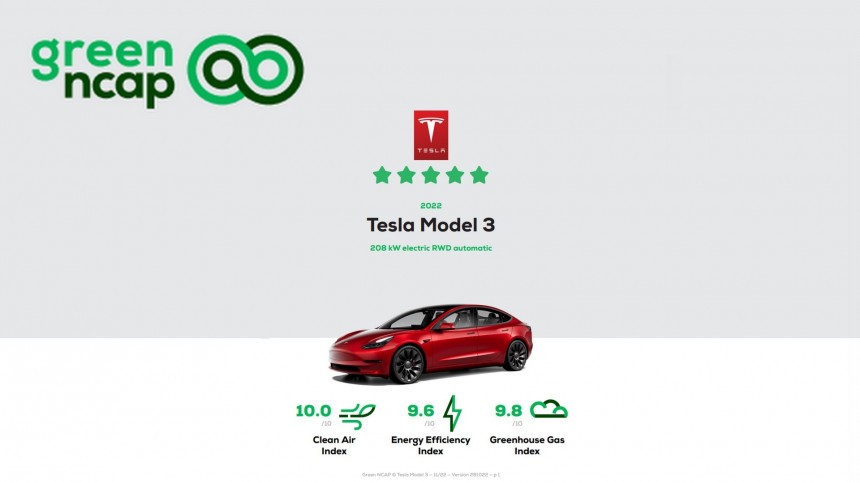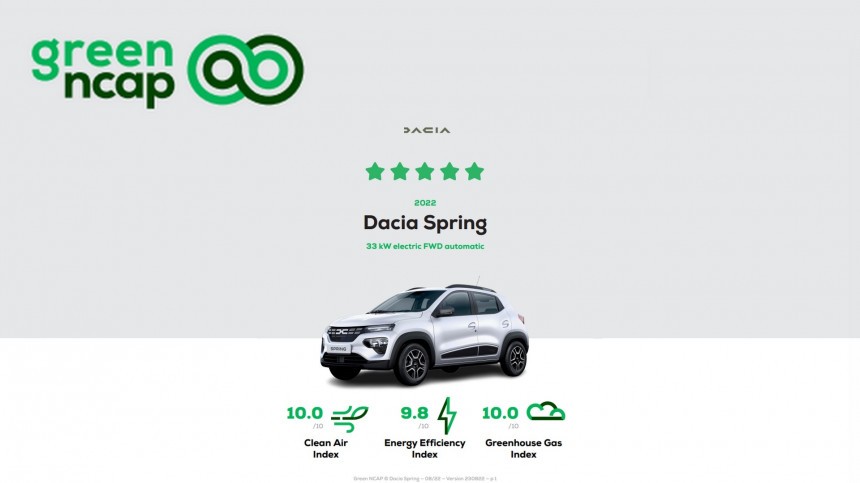Green NCAP tests are only made with rental vehicles because they have to have a certain mileage before emissions and efficiency can be measured appropriately. We thought this was what was delaying a test with Tesla vehicles, but the wait is finally over. The organization tested the entry-level Model 3 and was impressed with its efficiency. Despite that, the Dacia Spring is still the most efficient electric car it tested this year.
If we check the vehicles Green NCAP tested in 2021 and 2020, there are better results, with the Hyundai Kona Electric and Renault ZOE getting all the points in all categories. That was clearly a mistake that the organization corrected to avoid giving all EVs the same grades regardless of how efficient they were or not. That said, we should only consider the latest results, which are more refined than the earlier ones.
Green NCAP wrote that the Model 3 “achieved high energy efficiency” and that “its small frontal area and aerodynamic shape work to the vehicle’s advantage.” What the Tesla did not manage to beat was the higher energetic demand in winter conditions (-7°C, or 19.4ºF) at the WLTC+ test cycle. That increased its energy consumption by 72%, lowering the range to 241 kilometers (150 miles).
Tesla officially states the WLTP range is 491 km (305 mi). However, Green NCAP said that you could expect ranges of up to 450 km when the weather is warm, thanks to an energy consumption “below 16 kWh/100 km” (3.9 miles/kWh). The 241 km (150 miles) of range in winter are less than half the official numbers.
The Dacia Spring has an official WLTP range of 305 km (189 mi). Green NCAP said it only managed to run 141 km (87.6 mi) in the worst-case scenario, with an energy consumption of 23 kWh/100 km (4.3 mi/kWh). Considering the cold ambient tests presented an energy consumption of 22.5 kWh/100 km (2.7 mi/kWh), these dire conditions must be those in low temperatures. That makes the Spring also lose more than half of its original range in the winter.
Although it may seem unfair that the Tesla has a lower grade for the cold ambient tests than the Dacia, it appears to relate to how much more energy it demands. The 72% higher energy need in the Model 3 happens when compared to the cold test energy consumption (16.5 kWh/100 km, or 3.8 mi/kWh). The Spring uses 16.2 kWh/100 km (3.9 mi/kWh) in the cold test, which makes the 22.5 kWh/100 km 38.9% higher.
The Model 3 had 10 out of 10 on Clean Air Index, 9.6 on the Energy Efficiency Index, and 9.8 on the Greenhouse Gas Index. The Dacia Spring, with its air-cooled battery pack, scored respectively 10, 9.8, and 10.
Curiously, the NIO ET7 presents the same energy demand increase as the Model 3: 72%. The larger electric sedan was also tested by Green NCAP despite having just arrived in Europe, which makes us wonder where the organization managed to get a rental unit (China, perhaps?). Despite the small frontal area and the excellent drag coefficient, the ET7 is heavy, weighing 2.4 metric tons (5,291 pounds). The NIO scored 10, 9.4, and 9.6.
The Mégane E-Tech Electric had the same marks as the Chinese sedan. Sadly for Renault, its energy consumption in cold ambient tests is almost as high as that of the ET7: 30 kWh/100 km (2.1 mi/kWh), while the NIO spends 30.4 kWh/100 km (2 mi/kWh).
To sum it all up, Green NCAP tested three of the most desirable electric vehicles currently available. None of them compare to the most affordable electric car for sale in Europe. Isn’t it ironic that the simplest of all EVs currently for sale is also the most efficient one?
Green NCAP wrote that the Model 3 “achieved high energy efficiency” and that “its small frontal area and aerodynamic shape work to the vehicle’s advantage.” What the Tesla did not manage to beat was the higher energetic demand in winter conditions (-7°C, or 19.4ºF) at the WLTC+ test cycle. That increased its energy consumption by 72%, lowering the range to 241 kilometers (150 miles).
Tesla officially states the WLTP range is 491 km (305 mi). However, Green NCAP said that you could expect ranges of up to 450 km when the weather is warm, thanks to an energy consumption “below 16 kWh/100 km” (3.9 miles/kWh). The 241 km (150 miles) of range in winter are less than half the official numbers.
Although it may seem unfair that the Tesla has a lower grade for the cold ambient tests than the Dacia, it appears to relate to how much more energy it demands. The 72% higher energy need in the Model 3 happens when compared to the cold test energy consumption (16.5 kWh/100 km, or 3.8 mi/kWh). The Spring uses 16.2 kWh/100 km (3.9 mi/kWh) in the cold test, which makes the 22.5 kWh/100 km 38.9% higher.
The Model 3 had 10 out of 10 on Clean Air Index, 9.6 on the Energy Efficiency Index, and 9.8 on the Greenhouse Gas Index. The Dacia Spring, with its air-cooled battery pack, scored respectively 10, 9.8, and 10.
The Mégane E-Tech Electric had the same marks as the Chinese sedan. Sadly for Renault, its energy consumption in cold ambient tests is almost as high as that of the ET7: 30 kWh/100 km (2.1 mi/kWh), while the NIO spends 30.4 kWh/100 km (2 mi/kWh).
To sum it all up, Green NCAP tested three of the most desirable electric vehicles currently available. None of them compare to the most affordable electric car for sale in Europe. Isn’t it ironic that the simplest of all EVs currently for sale is also the most efficient one?









